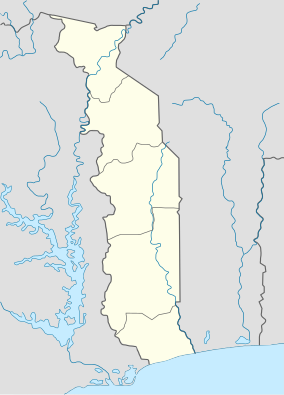Fazao Malfakassa National Park
| Fazao Malfakassa National Park | |
|---|---|
| Parc National de Fazao Malfakassa | |
| Location | Kara Region and Centrale Region Togo |
| Area | 1,920 km2 (740 sq mi) |
| Established | 1975 |
Fazao Malfakassa National Park[1][2] is the largest National Park in Togo.[3] It is situated between the Kara Region and Centrale Region in semi-mountainous wetland.
It was established in 1975 by the merger of two reserve forests created in 1951: Fazao (1,620 square kilometres (630 sq mi)} and Malfakassa (300 square kilometres (120 sq mi)}.[4] The Forest Classée Du Fazao contains most of the biodiversity of the forest, and Malfacassa Zone de Chasse is where visitors go hiking in the rocky hills. The terrain includes "savanna woodland ... good stands of gallery forest ... , submontane forest and grass-covered hilltops."[5]
The site is currently being considered for inclusion in the World Heritage list of sites with "outstanding universal value" to the world.[6] This site was added to the UNESCO World Heritage Tentative List on January 8, 2002, in the Mixed (Cultural + Natural) category.[7]
Fauna
In 1990, elephants were common in northeastern Togo.[8] With the country in a state of upheaval in the early 1990s, poaching became a major problem.[9] By 2007, the population had been reduced to a remnant in the park. The number of elephants in the park was estimated to be around 50 in 2003.[8] The park is one of two in Togo in the CITES Monitoring of Illegal Killing of Elephants Program.[8]
The total number of bird species is 244, as of 2008,[10] but there are likely many more.[5]
References
- ^ Parks and reserves of Ghana : management effectiveness assessment of protected areas. IUCN. ISBN 9782831712772.
- ^ Planet, Lonely (2010-01-01). The Travel Book: A Journey Through Every Country in the World. Lonely Planet. ISBN 9781741792119.
- ^ Planet, Lonely; Ham, Anthony; Carillet, Jean-Bernard; Clammer, Paul; Filou, Emilie; Masters, Tom; Mutic, Anja; Sieg, Caroline; Thomas, Kate (2013-08-01). Lonely Planet West Africa. Lonely Planet. ISBN 9781743217825.
- ^ T. T. K. Tchamie. "Learning from local hostility to protected areas in Togo". Food and Agriculture Organization of the United Nations.
- ^ a b "Fazao-Malfakassa National Park". BirdLife International.
- ^ World Heritage Center: The Criteria for Selection
- ^ Parc national de Fazao Mafakassa - UNESCO World Heritage Centre
- ^ a b c Scott Posner, USDA Forest Service (20 February 2008). "Togo: 118/119 Biodiversity and Forest Assessment" (PDF).
- ^ "Fazao Malfakassa National Park - Togo". Fondation Franz Weber.
- ^ Radley, P. M.; Campbell, G. (September 2008). "Birds of Fazao-Malfakassa National Park, Togo". Bulletin of the African Bird Club. African Bird Club.
